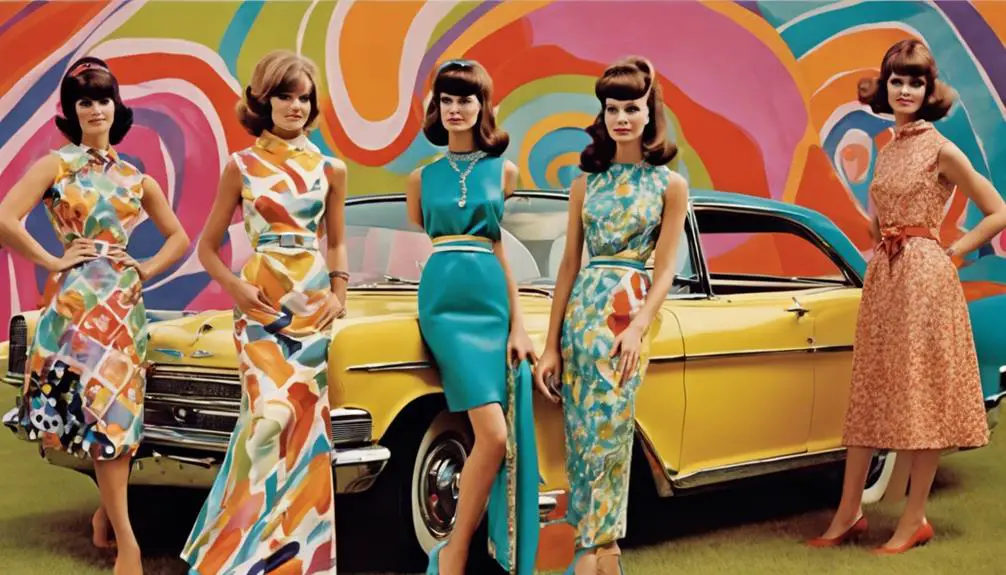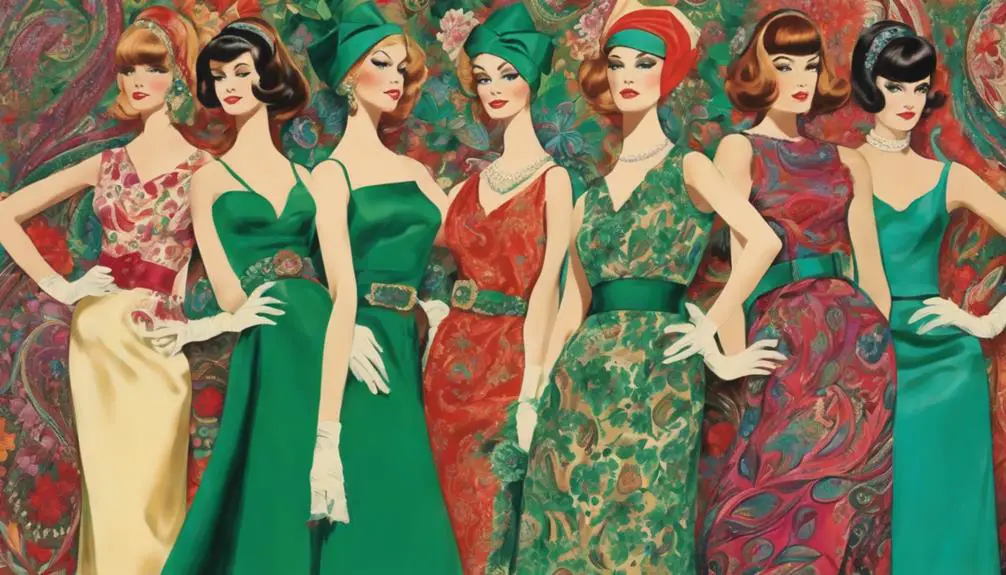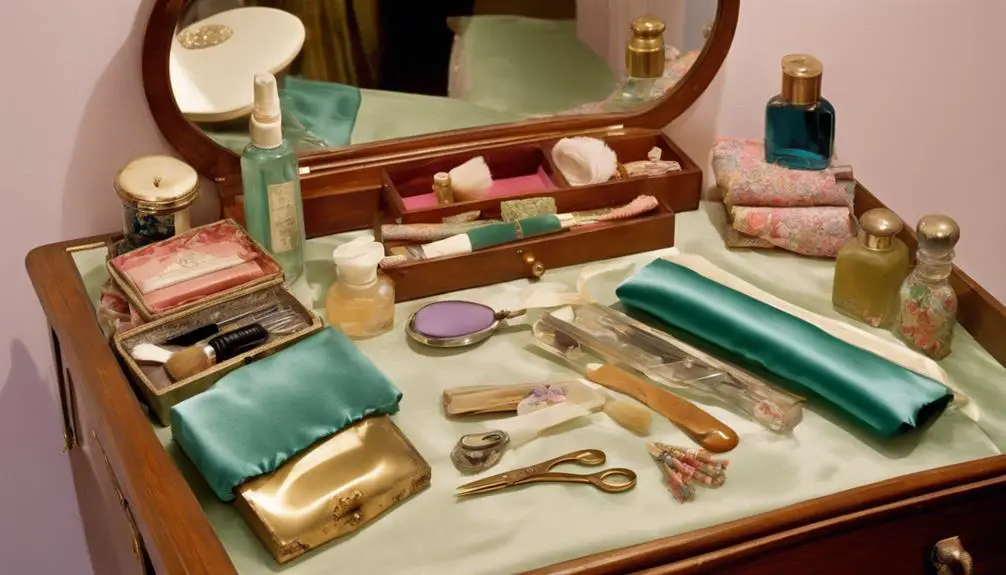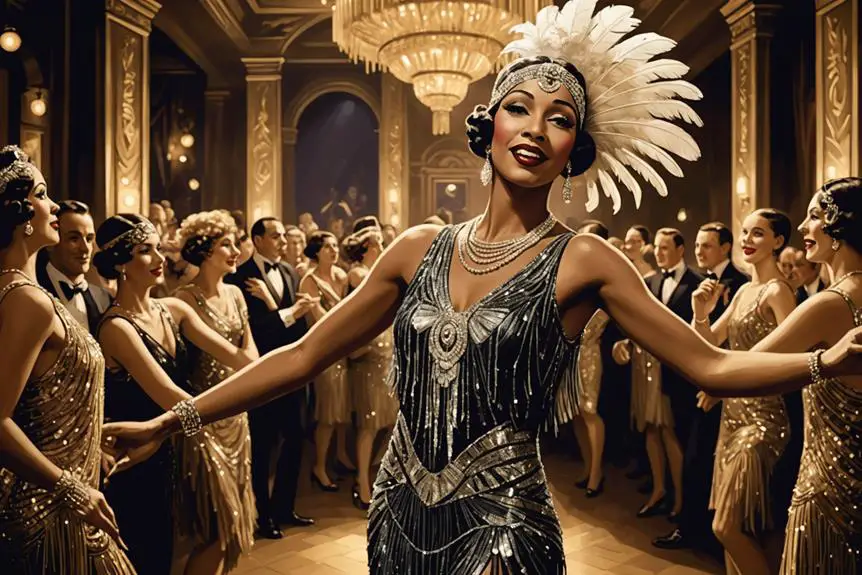In the 1960s, women's satin sashes became essential fashion accessories, reflecting societal changes and Hollywood influence. You'll notice how these sashes accentuated waistlines, creating flattering hourglass figures in fit-and-flare dresses. Designers like Givenchy and Dior used rich colors like hot pink and deep blue, adding vibrancy and sophistication to various outfits. The cultural backdrop, including the women's liberation movement, pushed for practical yet elegant styles, making sashes symbols of luxury. They harmonized beautifully with bold patterns and playful aesthetics, showcasing a glamorous side of women's fashion. If you explore further, you'll uncover even more fascinating details about this era's style evolution.
Evolution of Satin Sashes

The evolution of satin sashes in the 1960s showcases a significant shift in fashion that combined both practicality and elegance. You'll notice how these accessories transformed the way women styled their outfits, often accentuating the waistline of dresses. Influenced by Hollywood's glamorous trends, satin sashes became synonymous with cinched waists and flowing silhouettes, marrying comfort with sophisticated aesthetics. During this period, the emergence of unique vintage clothing labels also helped define the quality and craftsmanship of garments, making satin sashes an integral part of fashionable ensembles.
As you explore the decade, you can see that the colors and patterns of satin sashes varied widely. Bright hues and floral designs reflected the vibrant fashion ethos, adding a lively touch to attire. This versatility allowed satin sashes to seamlessly fit into both casual and formal settings, whether you were donning a cocktail dress or an evening gown.
Incorporating satin sashes into vintage dresses highlighted the luxurious feel of the fabric, enhancing the overall appeal of the garment. By observing this evolution, you may appreciate how these accessories elevated the fashion narrative of the 1960s, allowing women to express individuality while embracing elegance. Satin sashes consequently emerged not just as adornments but as essential elements in the fashion landscape of the era.
Iconic Dress Styles
Satin sashes perfectly complemented the iconic dress styles of the 1960s, enhancing the overall silhouette and adding an element of sophistication. The fit-and-flare design became a staple during this decade, where you'd find satin sashes cinching the waist, creating a flattering hourglass figure that echoed the glamorous looks of Hollywood stars. These sashes not only accentuated the dresses but also served as statement pieces that elevated the entire outfit.
As you explored the vibrant fashion scene, you'd notice how satin sashes harmonized with bold patterns, such as floral prints and geometric designs, often seen in mod-style dresses. Many vintage satin dresses showcased wide sashes that could be tied into elaborate bows, introducing a playful yet chic aesthetic.
Designers like Givenchy and Dior played a significant role in popularizing these styles, incorporating satin sashes into their collections and reflecting the era's dedication to luxurious fabrics and meticulous craftsmanship. Pairing a satin sash with a striking velvet jacket could transform any dress into a sophisticated ensemble, showcasing your refined taste and appreciation for the artistry of 1960s fashion.
Popular Colors and Patterns

Frequently, vibrant colors and striking patterns defined the appeal of satin sashes in the 1960s, making them essential components of fashionable ensembles. Women embraced bold choices that perfectly complemented their outfits. Here are three popular options:
- Hot Pink – This eye-catching hue became synonymous with youthful exuberance and playful elegance.
- Deep Blue – A sophisticated color that added depth and richness to evening wear, ideal for cocktail parties.
- Classic Black – Timeless and versatile, black satin sashes provided a chic contrast against lighter dresses.
In addition to these vibrant colors, patterns such as floral prints and geometric designs flourished during this period. Polka dot sashes were particularly trendy, offering a whimsical touch to various garments. These sashes weren't merely functional; they were often embellished with beading or appliqué, enhancing the overall aesthetic.
The combination of contrasting colors became a popular styling choice, as pairing a light-colored dress with a dark satin sash created striking visual interest. Overall, the colors and patterns of satin sashes in the 1960s reflected a daring spirit that characterized the era, elevating women's fashion to new heights.
Cultural Influences on Fashion
Cultural influences in the 1960s transformed women's fashion, with satin sashes emerging as quintessential accessories that reflected the era's evolving social norms and aesthetic preferences. The rise of Hollywood icons like Audrey Hepburn played a pivotal role, as her elegant style popularized satin sashes as must-have items for cocktail dresses and evening wear. These sashes accentuated the waistline, aligning with the decade's emphasis on feminine silhouettes and the hourglass figure.
The Mod fashion movement further diversified satin sashes, introducing bold colors and patterns that complemented playful aesthetics. Additionally, cultural shifts, particularly the women's liberation movement, encouraged versatile fashion choices, making satin sashes both stylish and practical. Designer labels elevated these sashes to symbols of luxury, often embellished to enhance the glamour of evening gowns.
| Influence | Description | Example |
|---|---|---|
| Hollywood Icons | Celebrities like Audrey Hepburn set trends | Satin sashes in films |
| Mod Fashion | Embraced vibrant colors and patterns | Bold, playful sashes |
| Women's Movement | Promoted functional, versatile fashion choices | Sashes as practical wear |
The interplay of these influences solidified satin sashes as a defining feature of 1960s fashion.
Care and Preservation Tips

As satin sashes became a staple of 1960s fashion, understanding how to care for and preserve these delicate accessories is vital for maintaining their beauty and longevity. Simply put, following a few key practices can extend the life of your sashes:
- Regular Dry Cleaning: Make sure you dry clean your satin sashes regularly to maintain their luster and prevent fabric deterioration.
- Proper Storage: Store your sashes in a cool, dry place away from direct sunlight to avoid fading and damage.
- Frequent Inspections: Regularly inspect your sashes for wear and tear to address any signs of damage before they worsen.
Handling satin sashes with care is important. Avoid snagging or damaging delicate embellishments during wear or storage. When you're not using them, wrap your sashes in acid-free tissue paper. This helps preserve their shape and prevents unwanted creasing. By incorporating these care and preservation tips, you'll guarantee that your 1960s satin sashes remain a vibrant part of your wardrobe, echoing the stylish elegance of their era for years to come.
Frequently Asked Questions
How Were Satin Sashes Typically Styled in the 1960s?
Satin sashes in the 1960s were often styled as eye-catching accessories, cinching waistlines on dresses or blouses. You'd see vibrant colors and patterns, enhancing silhouettes and adding elegance to both casual and formal outfits.
What Materials Were Commonly Used Alongside Satin for Sashes?
When creating sashes, you'd often find materials like silk, chiffon, or organza used alongside satin. These fabrics added texture and contrast, enhancing the overall aesthetic while providing versatility in styling and draping for various occasions.
Did Men Wear Satin Sashes During the 1960s?
Men didn't widely wear satin sashes during the 1960s. While fashion was evolving, satin was primarily associated with women's clothing. You'll find that men's accessories leaned towards fabrics like cotton and wool instead.
Were Satin Sashes a Global Fashion Trend or Localized?
Satin sashes weren't just a localized trend; they reflected broader fashion movements. You'll find their influence across various cultures, showcasing unique styles and adaptations, proving that fashion often transcends geographical boundaries and personal expression.
How Did the Availability of Satin Sashes Change Over the Decade?
As the decade progressed, you noticed satin sashes becoming more accessible due to increased textile production and evolving fashion trends. This shift allowed you to experiment with styles, enhancing your wardrobe and personal expression markedly.





Thanks a lot for sharing this with all people you really recognize what you’re speaking approximately!
Bookmarked. Please also discuss with my web site =). We may have a hyperlink trade arrangement among us